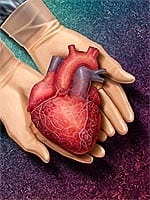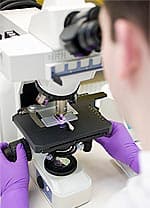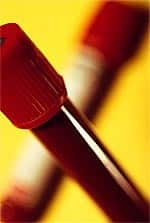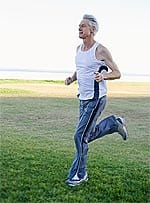Life Extension Magazine®
We at Life Extension are sometimes asked why we check estrogen levels when testing the blood of our male members. Long ago, we published data showing that estrogen levels are often elevated in aging men and discussed the insidious health risks associated with excess estrogen. Since it is so easy for men to correct estrogen overload, it made sense to test for it and recommend the appropriate corrective actions if blood results reveal excessive (or deficient) estrogen. A presentation at a recent anti-aging conference suggested that higher estrogen levels are beneficial to aging men. This prompted us to search the published scientific literature to see if we had overlooked some recent findings. What we uncovered not only confirmed our original recommendation, but revealed that excess estrogen in aging men is more dangerous than what we even thought. What you need to knowThe importance of testosterone in aging men has been widely disseminated to the public, however, most men do not consider their estrogen levels. Men who are overweight or obese produce more of the enzyme aromatase, which converts testosterone into estrogen. Excessive fat increases the risk of a plethora of diseases, in addition to reducing testosterone and increasing estrogen in men. Maintaining healthy levels of estrogen in men is imperative to their health. Double the Stroke RiskStroke is the third leading cause of death and the leading cause of age-related disability. Abnormal blood clotting in the cerebral blood vessels is the most common cause of stroke. Excess estrogen promotes abnormal blood clots.1 In a study published just last year, blood levels of estradiol (a potent estrogen) were measured in a group of 2,197 men aged 71 to 93 years of age. Adjustment for age, hypertension, diabetes, adiposity, cholesterol, atrial fibrillation, and other characteristics were made. During the course of follow-up, men with the highest blood levels of estradiol had a 2.2-fold greater risk of stroke compared with those whose estradiol levels were lower.2 This study revealed that estradiol blood levels greater than 34.1 pg/mL resulted in this more than doubling of stroke incidence. Life Extension long ago warned men to keep their estradiol levels below 30 pg/mL, and this recent stroke study clearly validates our prior recommendation. Excess Estrogen in Middle-Aged MenOne way to evaluate the health of the arterial system is to measure the inner and medial wall of the carotid artery using an ultrasound test.
In a study published two years ago, blood levels of estradiol were measured in 313 men whose average age was 58. Carotid artery intima-media thickness was measured at baseline and then three years later. After adjusting for other risk factors, men with higher levels of estradiol suffered a worsening thickening of their carotid artery wall. This led the researchers to conclude, “circulating estradiol is a predictor of progression of carotid artery intima-media thickness in middle-aged men.”3 This study of middle-aged men was initiated based on findings that treatment of men with prostate cancer using orally ingested estrogen drugs is associated with increased cardiovascular events and deaths. Ultrasound measurement of the carotid artery wall provides an accurate prognostic indicator of arterial disease. The findings in this study show progression of carotid artery intima-media thickness in men with higher estradiol levels. Greater carotid artery intima-media thickness sharply correlates with increased risks of heart attack and stroke. Estradiol Higher in Male Heart Attack Victims
A study published just last year compared blood levels of testosterone and estradiol in men suffering acute myocardial infarction (heart attack) with those who had previously suffered a heart attack. Sex hormones were measured in patients presenting with acute heart attack, patients with old heart attack, and patients with normal coronary arteries. The results showed significantly higher levels of estradiol in both groups of heart attack patients compared with those without coronary disease.4 As would be expected from numerous prior studies, heart attack victims also had decreased testosterone levels. The reason many men suffer from excess estradiol and deficient testosterone is that their aging bodies produce less testosterone while more of their beneficial testosterone is converted (aromatized) into estradiol. The pathological result is an altering of the ratio of testosterone to estrogen, creating estrogen dominance.5 This imbalance of estrogen overload and testosterone insufficiency is an often overlooked cause of cardiovascular disease. Fortunately, there are safe methods to block the aromatase enzyme in order to lower excess estrogen while boosting free testosterone levels. High Estrogen in Men With Coronary AtherosclerosisAn invasive diagnostic procedure known as a coronary angiogram can measure the degree of atherosclerosis present in the arteries feeding the heart muscle. Researchers used angiogram-confirmed cases of coronary atherosclerosis to ascertain the effects of sex hormones and other metabolic factors in a group of men aged 40-60 years. Compared with healthy age-matched controls, men with coronary atherosclerosis had low testosterone, higher levels of estrone (another potent estrogen), and a low level of testosterone in the presence of a high level of estradiol.6 These findings led the researchers to conclude their study by stating, “low levels of total testosterone, testosterone/estradiol ratio and free androgen index and higher levels of estrone in men with coronary artery disease appear together with many features of metabolic syndrome and may be involved in the pathogenesis of coronary atherosclerosis.”
In a study conducted a year later by another research group, angiograms were used to measure the extent of coronary atherosclerosis in a group of men with stable coronary artery disease. The finding showed significant positive correlations between estradiol levels and other known atherosclerotic risk factors.7 The scientists concluded their study by stating, “our results indicate a possible role of estradiol in promoting the development of atherogenic lipid milieu in men with coronary artery disease.” These two recent studies validate other reports showing that excess estrogen promotes atherosclerosis in men. Peripheral Artery Disease and Sex HormonesPeripheral artery disease occurs when there is partial or total blockage of an artery, usually one leading to a leg or arm. Leg artery disease is usually due to atherosclerosis that impairs blood circulation. Those afflicted with this condition find that walking can bring on fatigue, cramping, and pain in the hip, buttock, thigh, knee, shin, or upper foot. A study published last year sought to determine whether blood levels of testosterone and estradiol are associated with lower extremity peripheral arterial disease in elderly men. The participants consisted of 3,014 men with peripheral artery disease who averaged 75.4 years of age. After factoring in age, current smoking, previous smoking, diabetes, hypertension, and body mass index, the findings showed that low levels of testosterone were independently and positively associated with peripheral artery disease as were high levels of estradiol.8 The doctors who conducted this study concluded, “this cross-sectional study shows for the first time that low serum testosterone and high serum estradiol levels associate with lower extremity peripheral artery disease in elderly men.” The pharmaceutical industry makes a fortune treating those with peripheral artery disease. Common drugs prescribed include those that lower blood sugar, lower cholesterol (statins), lower blood pressure, and lower risk of blood clot. A popular drug called Plavix® has been heavily advertised to treat peripheral and other arterial diseases. Based on what is known about the atherogenic and thrombotic risks of low testosterone and high estradiol, it is conceivable that men suffering from peripheral artery disease could discard many of their drugs if they restored their testosterone to youthful ranges and reduced excess estradiol. High Estradiol Levels Seen in Male Chronic Inflammation PatientsRheumatoid arthritis is a severe chronic inflammatory state that results in increased risks of heart attack, cancer, and stroke. A study of men with rheumatoid arthritis evaluated blood levels of sex hormones compared with healthy controls.9 Levels of estradiol in rheumatoid arthritis patients were higher and DHEA levels lower compared with subjects who were not suffering from chronic inflammation.9 This corresponds to studies showing that high estrogen levels (in women) can increase C-reactive protein, which is the most accurate marker for systemic inflammation.10-12 Elevated C-reactive protein is an independent risk factor for coronary heart disease in healthy individuals. Another Lethal Mechanism of Excess Estrogen
The number one cause of death in persons over age 50 is the development of an abnormal blood clot (thrombus) in an artery that blocks blood flow to a critical region of the body such as the heart, lungs, or brain. Elevated estrogen predisposes people to these lethal thrombotic events. It has been found that men admitted in hospitals with myocardial infarcts have elevated estradiol and lower testosterone levels.13 This was shown in an interesting study done on men admitted to the hospital with acute heart attacks whose levels of sex hormones were evaluated. Compared with control patients, estradiol levels in these heart attack patients were 180% higher, while bioavailable testosterone levels were nearly three times less than those of control patients.14 These findings reveal the higher heart attack incidences associated with high estrogen and low testosterone. It is possible, however, that these low levels of testosterone and high levels of estradiol occurred in response to the heart attack itself.14 Estrogen and Prostate CancerThe role that estrogen plays in malignant prostate disease is contradictory and complex. Some studies indicate that estrogen and its toxic metabolites are a cause of prostate cancer.15,16 Yet once prostate cancer develops, certain estrogen compounds demonstrate anticancer effects. This paradox can be explained by the mechanisms that estradiol (and its toxic metabolites) uses to damage prostate cell DNA,17 causing gene mutations that result in the loss of cell growth regulatory control, i.e. cancer. Interestingly, once a prostate tumor manifests, estrogen may exert anti-tumor effects, though cancer cells eventually become resistant to estrogen drugs and then even use endogenous estrogen to fuel their growth. The fact that estrogen may temporarily exert anti-tumor effects in certain types of prostate cancer cells does not diminish the argument that estrogen may have contributed to the initiation of the same cancer. For example, in a study published two years ago, researchers discovered that when “estradiol is added to testosterone treatment of rats, prostate cancer incidence is markedly increased and even a short course of estrogen treatment results in a high incidence of prostate cancer.” These scientists hypothesize that metabolites of estrogens can be converted to reactive intermediates that can adduct to DNA and cause generation of reactive oxygen species; thus, estradiol is a weak DNA-damaging carcinogen that causes DNA damage to prostate cell genes.18 This kind of damage to DNA regulatory genes is what initiates prostate cancer. Many published studies, however, show no association between high blood estradiol levels and diagnosed prostate cancers.19 One reason there are not more diagnosed prostate cancers in men with high estrogen may be that the high estradiol level that initiated DNA damage then serves to keep prostate cancer temporarily under control once it develops. An interesting mechanism by which certain prostate cancer cells become resistant to estradiol therapy is the development of components in cancer cells that selectively remove estradiol from the tumor cells. If our normal cells were only as adaptive as cancer cells, we could possibly become biologically immortal. Another reason why estradiol blood levels may not correlate with prostate cancer incidence is the ability of prostate cells to produce their own estradiol (by making their own aromatase enzyme). Although evidence is conflicting, there is a clear indication that local synthesis of estrogen in the prostate gland itself may be significant in prostate tumor development.16 All of this helps validate the importance of nutrients Life Extension male members take to block the carcinogenic effects of estrogen within the prostate gland. An analogy to how excess estrogen can first damage DNA regulatory genes to cause cancer and then act as a prostate cancer suppressor can be seen with chemotherapy drugs. The mechanism by which most chemo drugs kill cancer cells is to inflict massive damage to cellular DNA. While chemo drugs kill cancer cells, they simultaneously damage healthy DNA and can increase the risk of future cancers. It appears that excess estrogen damages prostate cell DNA to initiate cancer, but then acts as a temporary prostate cancer suppressor. In presenting this analogy, I am not implying that estrogen in men is as dangerous as toxic chemo drugs. I am showing that something that suppresses cancer cell propagation (like estrogen) can also cause cancer. Our Observations
We at Life Extension have often observed aged men with symptom-free prostate cancer who have startlingly high estradiol levels. It requires a needle biopsy to confirm these slow growing tumors that were identified by only modestly high PSA levels. In fact, we often look at aging men’s estradiol and free testosterone blood levels as a potential indicator of prostate cancer. Aging men with low free testosterone and high estradiol often have prostate cancer based on these observations. Many of these men, however, will die from vascular disease (possibly caused by their high estrogen levels) before their prostate cancer is diagnosed. In fact, a study published just this year discusses potential initiating effect of estrogens in the development of prostate cancer.15 Tumor initiation is defined by the National Cancer Institute as a process in which normal cells are changed so that they are able to form tumors. Substances that cause cancer can be tumor initiators. The latest study on this subject suggests that estrogen is a prostate cancer initiator and that anti-estrogen therapies might be an overlooked prevention strategy. An overlooked reason so many human studies fail to show a relationship between estrogen levels and prostate cancer is the fact that men with the highest estrogen levels may have perished from heart attacks and strokes before prostate cancer had a chance to clinically manifest. Based on the vascular disease risks discussed at the beginning of this article, men who suffered from estrogen overload early in their life would be expected to die sooner and, therefore not live long enough to develop clinically diagnosed prostate cancer. From a statistical standpoint, this would falsely make it appear that higher estradiol levels in aging men do not result in greater incidences of prostate cancer, since many men with the highest estrogen levels would not be alive to even participate in the study.
Estrogen’s Role in Benign Prostate EnlargementUnlike prostate cancer, estrogen’s role in the development and progression of benign prostatic hyperplasia (BPH) is clearly defined. Animal studies initially led to the hypothesis that estrogens can stimulate prostate growth, resulting in hyperplasia of the gland. A large body of subsequent human research confirms the initial findings.15,20,29-32 Estrogen stimulates proliferation of the stromal cells in the prostate gland that cause so many of the urinary discomforts associated with BPH. A study published just this year documents a specific mechanism by which estradiol causes rapid proliferation of prostate stromal cells.15
Another study also published this year provides further clarification on how estradiol increases the proliferation of stromal cells and how anti-estrogen compounds block this undesirable effect. The researchers concluded that “…these findings support the hypothesis that estrogens play a role in the pathogenesis of BPH, a disease characterized predominantly by stromal overgrowth.”20 In a study published last year, researchers evaluated the association of sex hormone levels in the blood with common BPH urinary tract symptoms. Study subjects consisted of 260 men, 60 years of age or older, whose blood levels of testosterone, estradiol, and other sex hormones were measured. Of these men, 128 cases had two to four symptoms (excessive urination at night, hesitancy, incomplete emptying, and weak stream). The 132 men in the control group had no urinary symptoms. Adjustments were made for age, race/ethnicity, waist circumference, cigarette smoking, alcohol consumption, and physical activity.33 The results showed that BPH sufferers had statistically significantly greater estradiol concentrations than symptom-free controls. Men suffering from BPH symptoms also had higher levels of a marker for a metabolite for dihydrotestosterone (DHT, another documented factor in the development of BPH). After multivariate adjustments, men with the greater estradiol concentration had a 1.78 times higher incidence of urinary tract symptoms. An even greater incidence of urinary tract symptoms occurred in men with the highest levels of a dihydrotestosterone metabolite, whereas blood testosterone level showed no effect on urinary tract symptoms. The doctors who conducted this study concluded by stating, “in this cross-sectional study representative of older US men, circulating AAG, a metabolite of dihydrotestosterone, and estradiol were associated with an increased risk of having lower urinary tract symptoms.”33 These findings, reported over the past 18 months confirm what Life Extension told its members back in 1994 about estrogen’s role in benign prostatic hyperplasia (BPH). The encouraging news is that most Life Extension male members are already taking nutrients (and in some cases drugs like Arimidex® and Avodart®) that exhibit anti-estrogen and anti-DHT properties in the prostate gland itself. This is important because even when estrogen and DHT are lowered in the blood, prostate cells can compensate by synthesizing them in the prostate gland. |
|||||||||||
How Excess Estrogen Levels Occur in Aging MenIn males, the main biologically active estrogen is estradiol. The primary source of estradiol in men is from the conversion (aromatization) of testosterone. As men age, the production of androgens from the adrenals and gonads is decreased. The aromatization of testosterone to estradiol is often maintained, but due to a variety of factors, more testosterone is aromatized in fatty tissues, causing a further imbalance of the ratio of testosterone to estrogen, i.e. too much estradiol and not enough testosterone. The result is a deficiency of beneficial testosterone and an excess amount of estradiol.34 As men age, the amount of testosterone produced in the testes diminishes greatly. Yet estradiol levels remain persistently high. The reason for this is increasing aromatase activity along with age-associated fat mass, especially in the belly.5 Estradiol levels correlate significantly to body fat mass and more specifically to subcutaneous abdominal fat. The epidemic of abdominal obesity observed in aging men is associated with a constellation of degenerative disorders, including heart disease, diabetes, and cancer.9,35-38 Subcutaneous abdominal fat acts as a secretory gland, often producing and emitting excessive levels of estradiol into an aging man's blood.39 One's waist circumference is a highly accurate prognostic measurement of future disease risk, with excess estradiol secretion being at least one of the deadly mechanisms associated with the difficult-to-resolve problem of having too much abdominal fat.5,40 Symptoms of excess estrogen in aging men include the development of breasts, having too much abdominal weight, feeling tired, suffering loss of muscle mass, and having emotional disturbances. Many of these symptoms correspond to testosterone deficiency as well.41
Don't Lower Your Estrogen Too Much!When reviewing the studies about the multiple pathological effects of excess estrogen in aging men, it may be tempting to take high doses of an aromatase-inhibiting drug (like Arimidex®) to slash estrogen levels as low as possible. Don't do this, as men need estrogen to maintain bone density, cognitive function, and even to maintain the inner lining of the arterial wall (the endothelium).42 We have recommended that ideal ranges for estradiol for most aging men are between 20 and 30 pg/mL of blood. Below 18 pg/mL increases osteoporosis risk, while levels greater than 32 pg/mL increase heart attack and stroke incidence. The availability of low-cost blood tests enables aging men to optimize their estradiol levels using natural approaches and/or prescription drugs. Estrogen and Men's BonesOsteoporosis is not just a risk for aging women. Men also suffer crippling fractures caused by loss of bone mineral density. When aged men suffer a bone fracture, their risk of dying is significantly higher than women.43,44 In a study published two years ago, doctors analyzed blood levels in three groups of men for estradiol only, testosterone only, and estradiol and testosterone together. In men with low estradiol (2.0-18.1 pg/mL of blood), hip fractures were more than three times higher compared with men who had estradiol levels of 18.2-34.2 pg/mL.45 Men with estradiol levels greater than 34.3 pg/mL had a slightly higher risk of hip fracture compared with those in the range of 18.2-34.2 pg/mL. This study helps confirm Life Extension's recommended range for estrogen levels in aging men. Interestingly, this study also showed in the group of men whose blood was measured for estradiol and testosterone, those who were low in both these hormones suffered a startling 6.5 times greater incidence of hip fractures. The authors of this study concluded, "men with low estradiol levels are at an increased risk for future hip fracture. Men with both low estradiol and low testosterone levels seem to be at greatest risk for hip fracture."45 Conflicting DataWith the voluminous amount of scientific studies being published today, contradictions inevitably arise, and this is not always due to study design flaws.
For the past decade, Life Extension has reported on dozens of studies showing that higher testosterone levels significantly reduce a man's risk of cardiovascular disease. In fact, we just did a comprehensive database search and identified a total of 50 studies that document the protective effects of testosterone against cardiovascular disease in men. A study published two years ago, however, contradicts this. This study showed greater incidences of heart attacks in men with higher testosterone and lower heart attack risks in older men with higher estradiol. (In younger men, estradiol level had no impact on heart attack incidence in this study.) The authors of the study admitted a limitation to the study was only measuring baseline levels of hormones. This study nonetheless was used at the anti-aging conference to proclaim that estradiol protects against heart attack.46 There are scientific studies that demonstrate estrogen's potential beneficial effects to a man's vascular system. These protective mechanisms, however, have to be weighed against pathological damage the very same estrogen can induce. As I mentioned earlier, despite the documented dangers of excess estrogen, levels that are too low also present risks, not only to bone,45,47-49 but to the vascular system as well.46,50,51 If a man were to intentionally lower his estradiol too much, he could very well suffer vascular disease because estrogen is vital to proper endothelial function.52,53 This is why it is so important for aging men to have annual blood tests. If estrogen is too low (below 18-20 pg/mL), or too high (above 30 pg/mL), corrective action should be taken. How to Reduce Excess EstrogenIn aging men, a large percentage of estradiol is synthesized in abdominal adipose (fat) tissues.42 Reducing waist circumference confers huge health benefits, one being a lowering of estradiol levels. One of the most effective ways for men to reduce belly fat is to restore their free testosterone to youthful ranges. Nutrients that inhibit the aromatase enzyme can help boost testosterone levels by preventing its conversion (aromatization) into estradiol. As men grow older, however, their testicular testosterone production declines precipitously. This means that inhibiting aromatase might not sufficiently maintain testosterone levels because not enough is being produced internally. Fortunately, low-cost compounded testosterone creams are available that can be rubbed on the skin for absorption into the bloodstream. For men with excess aromatase activity, this topically absorbed testosterone might convert into too much estradiol. If this happens, the use of very low-dose aromatase-inhibiting drugs (0.5 mg of Arimidex® twice a week) may be all that is needed to protect against estrogen overload. Some men don't need these drugs and can use nutrient formulas that have aromatase-inhibiting properties. There is no need to guess what you need, as a blood test taken 30-45 days after initiating testosterone-replacement not only reveals a man's estradiol level, but also ensures that the PSA has not spiked (indicating possible pre-existing prostate cancer), that the dose of testosterone cream is appropriate, and that there are no other side effects occurring. To view a wide range of estrogen-lowering strategies, one can view Life Extension's Male Hormone Restoration Protocol. What if Your Estrogen Level is Too Low?Some men are so deficient in aromatase that they do not make enough estrogen. If a blood test reveals estradiol below 20 pg/mL, which may occur if Arimidex®, for example, is being taken at too high a dose, one should consider reducing the dose. Alternatively, applying a tiny dose of a compounded topical estradiol cream to the skin several times a week may also help increase estradiol levels. Follow-up blood tests 30-45 days later can assess if too much or too little topical estradiol cream is being used. There is also evidence that consuming phytoestrogens from soy might provide similar benefits for the bone75-79 and vascular system.80-88 Summary
It is hard to imagine that before 1906, doctors did not even know that a hormone (estrogen) was secreted by the ovaries in women. It was not until 1930 that the isolation of the estrogen complex in pure form was published. Less than 80 years later, scientists are debating what the optimal levels of estrogen should be in men. This exponential leap in scientific knowledge is a marvel in itself! The role that estrogen plays in men's health is an important topic discussed at medical conferences today. As outlined in this article, testing one's estradiol level is critical because it can be a serious problem if it is too high or if it is too low. I am pleased to announce that the everyday low price for the Male or Female Blood Test Panels has been reduced from $299 to $269. This price reduction is made possible by the large volume of blood testing Life Extension members have been ordering. In addition to estradiol, the Male Panel measures PSA, free testosterone, DHEA, C-reactive protein, homocysteine, along with cholesterol lipids, glucose, and blood cell counts and chemistries. I encourage any member who has not had this comprehensive blood test conducted over the past 12 months to take advantage of this new lower price. To order the Male or Female Panel by phone, call 1-800-208-3444. If the results reveal estradiol levels are too high or too low, corrective measures can easily be taken to protect your precious health. |
||||
| References | ||||
|










